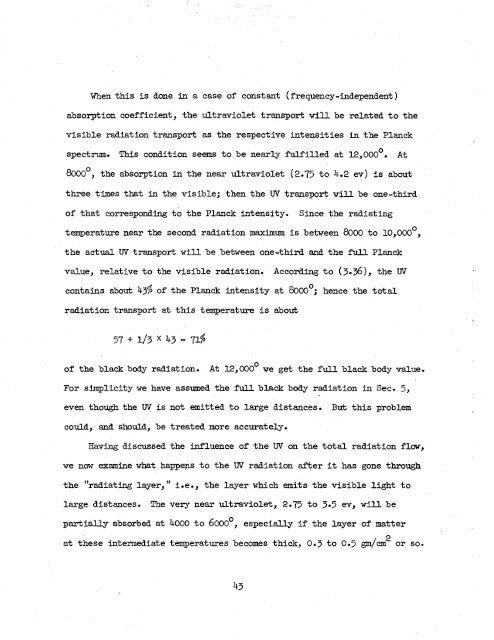Theory of the Fireball
Theory of the Fireball
Theory of the Fireball
Create successful ePaper yourself
Turn your PDF publications into a flip-book with our unique Google optimized e-Paper software.
When this is done in a case <strong>of</strong> constant ( frequency-independent )<br />
absorption coefficient, <strong>the</strong> ultraviolet transport will be related to <strong>the</strong><br />
visible radiation transport as <strong>the</strong> respective intensities in <strong>the</strong> Planck<br />
spectrum. This condition seems to be nearly fulfilled at 12,000°. At<br />
8000°, <strong>the</strong> absorption in <strong>the</strong> near ultraviolet (2.75 to 4.2 ev) is about<br />
three tines that in <strong>the</strong> visible; <strong>the</strong>n <strong>the</strong> W transport will be one-third<br />
<strong>of</strong> that corresponding to <strong>the</strong> Planck intensity. Since <strong>the</strong> radiating<br />
temperature near <strong>the</strong> second radiation maximum is between 8000 to 10,OOOo,<br />
<strong>the</strong> actual W transport will be between one-third and <strong>the</strong> full Planck<br />
value, relative to <strong>the</strong> visible radiation. According to (3.36), <strong>the</strong> W<br />
contains about 43$ ,<strong>of</strong> <strong>the</strong> Planck intensity at 8000'; hence <strong>the</strong> total<br />
radiation transport at this temperature is about<br />
<strong>of</strong> <strong>the</strong> black body radiation. At 12,000° we get <strong>the</strong> full black body value.<br />
For simplicity we have assumed <strong>the</strong> full black body radiation in Sec. 5, i<br />
even though <strong>the</strong> W is not emitted to large distances. But this problem<br />
could,. and should, be treated more accurately.<br />
Having discussed <strong>the</strong> influence <strong>of</strong> <strong>the</strong> W on <strong>the</strong> total radiation flow,<br />
we nuw examine what happens to <strong>the</strong> W radiation after it has gone through<br />
If<br />
<strong>the</strong> "radiating layer, i.e., <strong>the</strong> layer which emits <strong>the</strong> visible light to<br />
large distances. The very near ultraviolet, 2.75 to 3.5 ev, wiU. be<br />
partially absorbed at 4000 to 6000°, especially if <strong>the</strong> layer <strong>of</strong> matter<br />
2<br />
at <strong>the</strong>se intermediate temperatures becomes thick, 0.3 to 0.5 gm/cm or SO.<br />
/<br />
43
















